文章目录
函数重载的知识点
函数重载概述:
作用:函数名可以相同,提高复用性
函数重载满足条件:
- 同一个作用域下
- 函数名称相同
- 函数参数类型不同,或者个数不同或者顺序不同
注意:函数的返回值不可以作为函数重载的条件
#include <iostream>
using namespace std;
void fun()
{
cout << "this is a func" << endl;
}
void fun(int a)
{
cout << "this is a func(int a)" << endl;
}
int main()
{
fun(10);
fun();
system("pause");
return 0;
}
//注意事项:
//函数的返回值不可以作为函数重载的条件,这样会有二义性
1.函数重载的注意事项
- 引用作为重载的条件
#include <iostream>
using namespace std;
void fun(int& a)
{
cout << "this is a func(int& a)" << endl;
}
void fun(const int& a)
{
cout << "this is a func(const int& a)" << endl;
}
int main()
{
fun(10);
int a = 10;
fun(a);
system("pause");
return 0;
}
- 函数重载遇到默认参数
因为存在默认参数,在函数调用的时候,不写有的参数也可以调用,就会导致两个函数具有二义性,尽量避免
#include <iostream>
using namespace std;
void fun(int a)
{
cout << "this is a func(int a)" << endl;
}
void fun(int a, int b = 10)
{
cout << "this is a func(int a,int b)" << endl;
}
int main()
{
fun(10, 20);
//fun(10);两个函数都可以调用,产学生二义性
system("pause");
return 0;
}
运算符重载
运算符重载概念:对已有的运算符重新进行定义,赋予其另一种功能,以适应不同的数据类型
加号运算符重载
作用:实现两个自定义数据类型相加的运算
利用成员函数进行加号运算符的重载
#include <iostream>
using namespace std;
class Person {
public:
int m_A;
int m_B;
Person operator+(Person& p) {
Person temp;
temp.m_A = this->m_A + p.m_A;
temp.m_B = this->m_B + p.m_B;
return temp;
}
};
void text01() {
Person p1;
p1.m_A = 10;
p1.m_B = 10;
Person p2;
p2.m_A = 10;
p2.m_B = 10;
Person p3 = p1 + p2;
cout << p3.m_A << endl;
cout << p3.m_B << endl;
}
int main()
{
text01();
system("pause");
return 0;
}
利用全局函数进行加号运算符的重载
#include <iostream>
using namespace std;
class Person {
public:
int m_A;
int m_B;
};
Person operator+(Person& p1, Person& p2)
{
Person temp;
temp.m_A = p1.m_A + p2.m_A;
temp.m_B = p1.m_A + p2.m_B;
return temp;
}
void text01() {
Person p1;
p1.m_A = 10;
p1.m_B = 10;
Person p2;
p2.m_A = 10;
p2.m_B = 10;
Person p3 = p1 + p2;
cout << p3.m_A << endl;
cout << p3.m_B << endl;
}
int main()
{
text01();
system("pause");
return 0;
}
2.左移运算符重载
#include <iostream>
using namespace std;
class Person {
public:
int m_A;
int m_B;
};
//ostream这个对象只能由一个,只可以用全局函数
ostream& operator<<(ostream& cout, Person& p) {
cout << "m_A=" << p.m_A << " m_B= " << p.m_B;
return cout;
}
void text02()
{
Person p;
p.m_A = 10;
p.m_B = 10;
cout << p << endl;
}
int main()
{
text02();
system("pause");
return 0;
}
总结:重载左移运算符配合友元可以实现输出自定义的数据类型
递增运算符重载
#define _CRT_SECURE_NO_WARNINGS 1
#include <iostream>
using namespace std;
class Integer
{
//friend ostream& operator<< (ostream& cout, const Integer& temp);
public:
Integer() {}
//前置递增运算符重载:
Integer& operator++()
{
this->integer++;
return *this;
}
//后置递增运算符重载:
//注意返回值,非引用
Integer operator++(int)
{
Integer temp = *this;
this->integer++;
return temp;
}
//不是常函数,是因为传入的是const 修饰的对象,所以形参也要是const修饰的
//而第一个形参是编译器默认的this指针,不可以显式写出来,所以就在括号后面加一个const表示修饰的是this指针
void display() const
{
cout << this->integer;
}
protected:
private:
int integer{};
};
ostream& operator<< (ostream& cout, const Integer& temp)
{
//cout << "integer = " << temp.integer << endl;
temp.display();
return cout;
}
//输出的对象是一个类,需要重载运算符<<
//ostream& operator<< (ostream& cout, const Integer& temp)
//{
// cout << "integer = " << temp.integer << endl;
//}
void test01()
{
Integer pinteger01;
++pinteger01;
cout << (++pinteger01) << endl;
cout << pinteger01 << endl;
}
void test02()
{
Integer pinteger02;
pinteger02++;
cout << pinteger02++ << endl;
cout << pinteger02 << endl;
}
int main()
{
test01();
test02();
system("pause");
return 0;
}
//第一次调用:
//调用拷贝函数->原来的类的整数值+1->返回一个被拷贝后的类的对象
//第二次调用:
//调用拷贝函数(被拷贝的类的整数值已经在原来的基础上自增了)->原来的类的整数值+1->返回一个被拷贝后的类的对象
赋值运算符重载
#include <iostream>
#include<string>
using namespace std;
class People
{
public:
People(string name = "", int* ptr = NULL); // 普通构造函数,
People(const People& peo); //显示声明拷贝构造函数
~People();
void Display();
void SetAge(int age);
private:
string m_name;
int* mp_age;
};
People::People(string name, int* ptr)
{
m_name = name;
mp_age = ptr;
}
People::People(const People& peo)
{
this->m_name = peo.m_name;
this->mp_age = new int(*peo.mp_age); //重新申请一块内存来存放 age,避免两个对象使用同一块内存
}
People::~People()
{
delete mp_age; // 不重载赋值运算符时多次释放内存会导致崩溃。
mp_age = NULL;
}
void People::Display()
{
cout << m_name << " is age " << *mp_age << endl;
}
void People::SetAge(int age)
{
*mp_age = age;
}
int main()
{
int* ptr = new int(10);
string name = "Xiao Ming";
People people1 = People(name, ptr);
People people2;
people2 = people1; //不重载赋值运算符
people1.Display();
people2.Display();
people1.SetAge(15); // 修改 people1 age
people1.Display();
people2.Display();
system("pause");
return 0;
}
关系运算符重载
#include<iostream>
using namespace std;
#include<string>
//重载关系运算符
class Person
{
public:
Person(string name, int age)
{
m_name = name;
m_age = age;
}
//重载==号
bool operator==(Person& p)
{
if (this->m_name == p.m_name && this->m_age == p.m_age)
return true;
return false;
}
bool operator!=(Person& p)
{
if (this->m_name != p.m_name || this->m_age != p.m_age)
return true;
return false;
}
string m_name;
int m_age;
};
void test1()
{
Person p1("Tom", 18);
Person p2("Tom", 18);
if (p1 == p2)
{
cout << "p1==p2" << endl;
}
else
{
cout << "p1和p2是不相等的!" << endl;
}
if (p1 != p2)
{
cout << "p1!=p2" << endl;
}
else
{
cout << "p1和p2是相等的!" << endl;
}
}
int main()
{
test1();
system("pause");
return 0;
}
函数调用运算符重载
#include <iostream>
#include <string>
using namespace std;
//函数调用运算符重载
//打印输出类
class MyPrint
{
public:
//重载函数调用运算符
void operator()(string test)
{
cout << test << endl;
}
};
void MyPrint02(string test)
{
cout << test << endl;
}
void test01()
{
MyPrint myPrint;
myPrint("hello world");//由于使用起来非常类似于函数调用,因此称为仿函数
MyPrint02("hello world");
}
//仿函数非常灵活,没有固定的写法
//加法类
class MyAdd
{
public:
int operator()(int num1, int num2)
{
return num1 + num2;
}
};
void test02()
{
MyAdd myadd;
int ret = myadd(100, 100);
cout << "ret=" << ret << endl;
//匿名的函数对象
cout << MyAdd()(100, 100) << endl;
}
int main()
{
test01();
test02();
system("pause");
return 0;
}
运算符重载的实验结果
函数的返回值不可以作为函数重载的条件
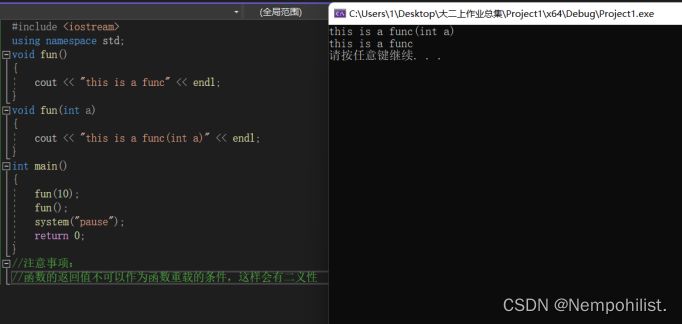
引用作为函数重载的条件
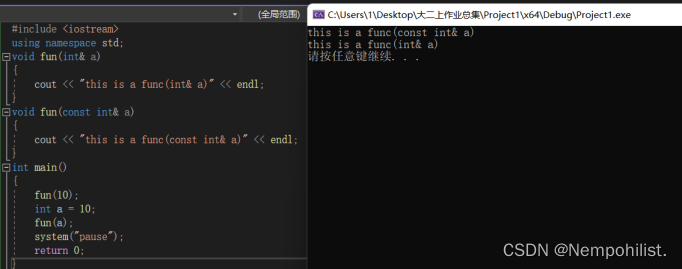
函数重载遇到默认参数
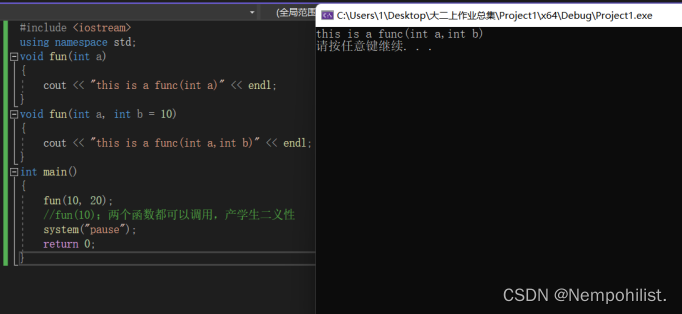
加法运算符——利用成员函数进行加法运算符的重载
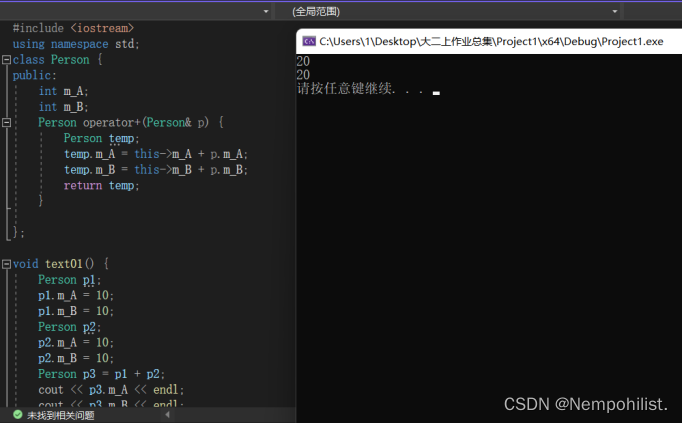
加法运算符——利用全局函数进行加法运算符的重载
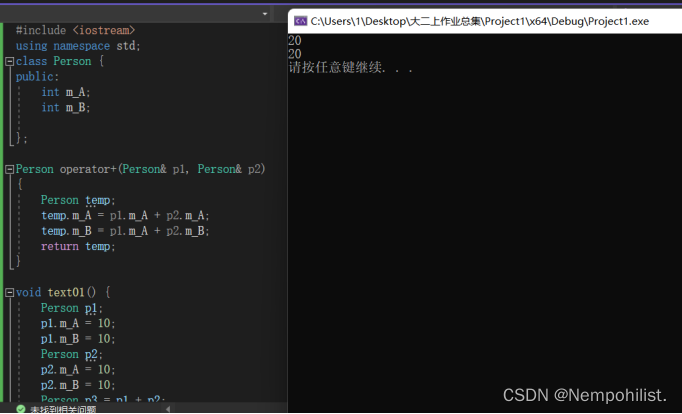
左移运算符的重载
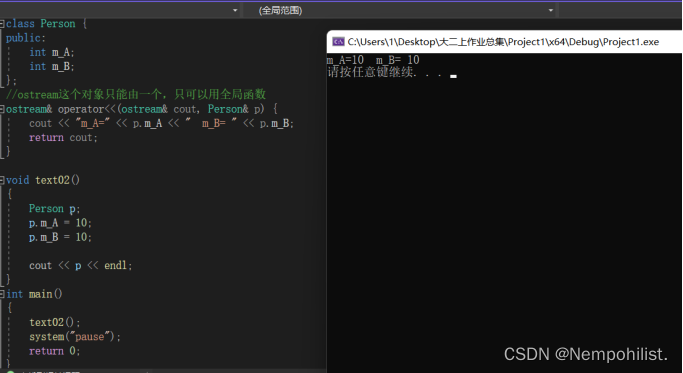
递增运算符的重载

赋值运算符的重载
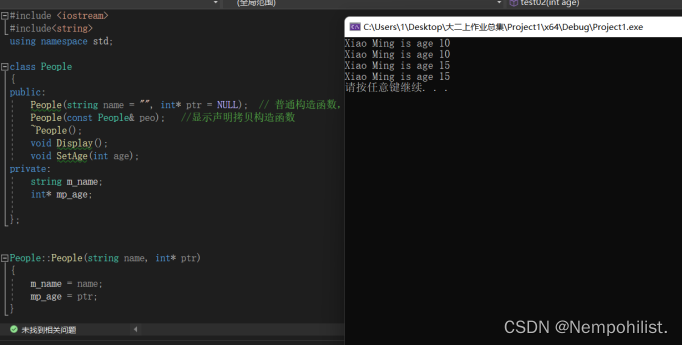
关系运算符的重载
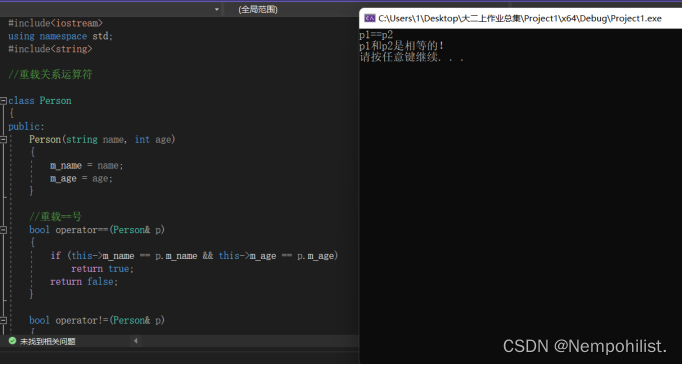
函数调用运算符的重载
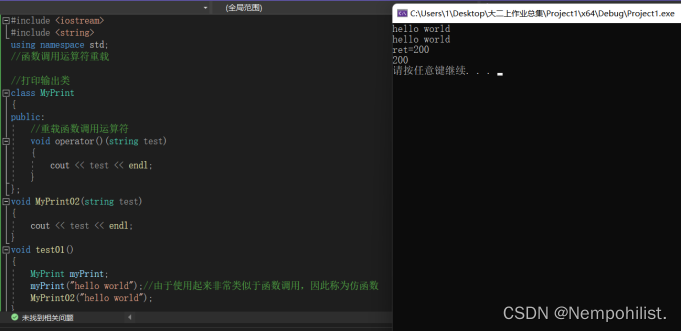
总结:通过这次实验,我基本掌握了通过运算符重载实现多态性的方法,学会了运算符重载的成员函数法和友元函数法,基本能够区分单目运算符的前置与后置。运算符重载是对已有的运算符赋予多重含义,使一个运算符作用域不同类型的数据导致不同行为的发生,C++为运算符重载提供一种方法,即运算符重载函数,其函数的名字规定为operator后紧跟重载运算符。重载运算符函数可以对运算符做出新的解释,即可以定义用户所需要的各种操作,但是运算符重载后,原有的基本语义不变,不改变运算符的优先级,不改变运算符的结结合性,不改变运算符所需要的操作数,不能创建新的运算符,优先级和结合性主要体现在重载运算符的使用上,而操作数的个数不但体现在重载运算符的使用上,更关系到函数定义时的参数设定。运算符的功能不能直接对他们进行操作,所以就需要我们对运算符进行重载,实际意思就是赋予运算符新的功能,让他们能够对我们自己定义的类和结构体进行操作。通过运算符的重载就能够看到C++的优越性,但是因为自己的基础不够好,所以应该多多锻炼,才能更加熟悉C++。





















 5694
5694











 被折叠的 条评论
为什么被折叠?
被折叠的 条评论
为什么被折叠?








